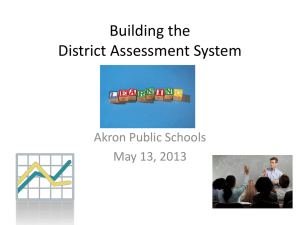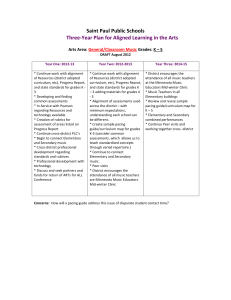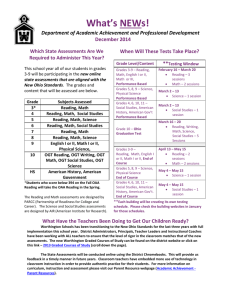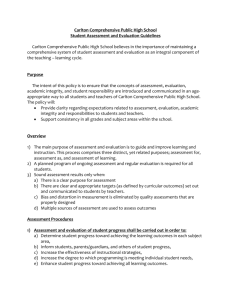MMUHS ACTION PLAN
advertisement
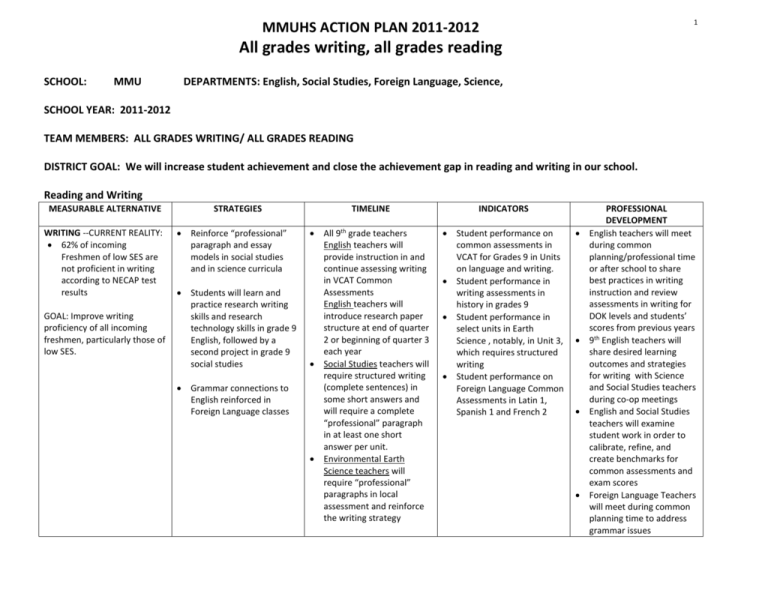
1 MMUHS ACTION PLAN 2011-2012 All grades writing, all grades reading SCHOOL: MMU DEPARTMENTS: English, Social Studies, Foreign Language, Science, SCHOOL YEAR: 2011-2012 TEAM MEMBERS: ALL GRADES WRITING/ ALL GRADES READING DISTRICT GOAL: We will increase student achievement and close the achievement gap in reading and writing in our school. Reading and Writing MEASURABLE ALTERNATIVE WRITING --CURRENT REALITY: 62% of incoming Freshmen of low SES are not proficient in writing according to NECAP test results GOAL: Improve writing proficiency of all incoming freshmen, particularly those of low SES. STRATEGIES Reinforce “professional” paragraph and essay models in social studies and in science curricula Students will learn and practice research writing skills and research technology skills in grade 9 English, followed by a second project in grade 9 social studies Grammar connections to English reinforced in Foreign Language classes TIMELINE INDICATORS All 9th grade teachers English teachers will provide instruction in and continue assessing writing in VCAT Common Assessments English teachers will introduce research paper structure at end of quarter 2 or beginning of quarter 3 each year Social Studies teachers will require structured writing (complete sentences) in some short answers and will require a complete “professional” paragraph in at least one short answer per unit. Environmental Earth Science teachers will require “professional” paragraphs in local assessment and reinforce the writing strategy Student performance on common assessments in VCAT for Grades 9 in Units on language and writing. Student performance in writing assessments in history in grades 9 Student performance in select units in Earth Science , notably, in Unit 3, which requires structured writing Student performance on Foreign Language Common Assessments in Latin 1, Spanish 1 and French 2 PROFESSIONAL DEVELOPMENT English teachers will meet during common planning/professional time or after school to share best practices in writing instruction and review assessments in writing for DOK levels and students’ scores from previous years 9th English teachers will share desired learning outcomes and strategies for writing with Science and Social Studies teachers during co-op meetings English and Social Studies teachers will examine student work in order to calibrate, refine, and create benchmarks for common assessments and exam scores Foreign Language Teachers will meet during common planning time to address grammar issues 2 ALL GRADES: WRITING MEASURABLE ALTERNATIVE Writing--CURRENT REALITY: 88% of current 11th grade students of low SES are not proficient in writing GOAL: Improve proficiency in writing in grades 10-12 particularly those of low SES. STRATEGIES All grades All English teachers provide direct instruction to students in writing and English grammar. Science and social studies will assess students in conventions and structures in their local assessments ________________________ English department to review writing structures and Conventions curriculum for each grade, paying particular attention to classes with high percentage of low SES students (10ELA) TIMELINE All grades On going 2011-2012 School Year Provide more opportunities for real-life writing for low- achieving students through differentiation Begin process in 20112012 curricular meeting s while discussing assessments and student work—continue following year as we move towards Common Core Standards Begin inclusion of technical writing instruction assignments in specific courses in Grade11 Provide instruction in technical writing. On going 2011-2012 School Year INDICATORS All grades Local Assessments will include measurement of grammar, usage, mechanics and writing structures _________________________ Student results on VCAT assessments where writing structures and conventions are measured Assessments that include writing in English, social studies and science reviewed and revised to ensure required writing includes “student interest,” a DI model, in some local assessments in each curricular area Draft of technical writing unit (s) for English 11for Career and College / 11 Technical English PROFESSIONAL DEVELOPMENT While reviewing common assessments and student work in curricular meetings, teachers will note student achievement in writing as measured on the local assessment rubrics Professional Days or inservice for some teachers in grammar instruction and support staff on differentiation Two members of English, Social Studies, and Science departments should participate in district curriculum committee meetings Curricular meetings where student work is examined will include discussion of writing instruction and how to include the “student interest” aspect of DI in local assessments Teacher will begin to develop technical writing units in technical English classes 3 ALL GRADES READING MEASURABLE ALTERNATIVE STRATEGIES Reading--CURRENT REALITY: 27% of incoming 9th grade students of low SES are not proficient in reading 44% of current 11th grade students of low SES are not proficient in reading GOAL: Improve proficiency of all students in reading, particularly those of low SES. Focus curricular meetings in English and Social studies on local and NECAP assessment data to determine where students are not meeting proficiency ____________________ Context course for 9th grade will include direct instruction of reading strategies and “Wide Reading” techniques Context course will use instructional strategies for building academic vocabulary Evaluate data on SDRT reading assessment for students in Context and a group of students not in context in a quasi experiment to determine if Context students have greater reading gains. English departments to standardize vocabulary study in each COURSE. TIMELINE All grades 2011-2012 teachers will review local and NECAP assessment data, evaluate Depth of Knowledge in all local assessments and review student work For Context study, school year 2011-2012. Students will be tested in fall and spring _____________________ 2011-2012, Semester 2, English Courses choose vocabulary units to teach and methods for instruction. (To be done as each unit is started.) 2012-2013 Academic Vocabulary in Science and Social studies standardization begins INDICATORS All grades Teachers will identify areas of strength and weakness in the data and student work and revise instructional strategies on VCAT to meet learner’s needs Compare student growth in reading in context to student growth in reading in two other ninth grade classes PROFESSIONAL DEVELOPMENT Focus in all curricular meetings on Step 4 of Curriculum Development cycle—data and assessment evaluation for improvement PD around data-based school improvement so that teachers can make curricular improvements as they observe local assessment data. PD time to review SDRT results from quasi experiment Vocabulary words and strategies included in VCAT by August 2012 _______________________ PD time during Inservice or in summer to standardize vocabulary words 4 MMUHS ACTION PLAN SCHOOL: MMU DEPARTMENT: Math SCHOOL YEAR: 2011-2012 TEAM MEMBERS: Math Department MMU DISTRICT GOAL: We will increase student achievement and close the achievement gap in math at MMU. MEASURABLE ALTERNATIVE CURRENT REALITY: 60% of our incoming 9th grades from low SES are not proficient in Math compared with 25 % of non-low SES population* 76% of current 11th grade students from a low SES are not proficient in Math, vs 44% of non-low SES population* GOAL: Improve math proficiency rate among all our students, especially of low SES students. * NECAP data (2010) CURRENT REALITY: Some students are not prealgebra or algebra ready when they get to high school. GOAL: Improve math readiness of incoming ninth graders. *Identify students who are not pre-algebra and algebra ready, support sending schools to ensure student readiness, and provide support to identified students at MMU. STRATEGIES Math teachers will have daily assignments posted on web Change the schedule so that most students get one hour of math instruction and tutoring every day. Use common assessment and classroom data to drive improvements in current and new math classes (Accelerated Math and Bridges to Algebra) Rework and update curricula to include new technology and textbooks Update curriculum to reflect the Common Core Standards for Mathematics Use the Math Lab, after school tutoring, and supplemental skill work to improve student’s skills Work with sending schools and provide clear guidance in placing incoming students Review data collected, including NECAP, ShawHiele and semester grade to help determine student readiness and support needs Parent contact and communication to support student work habits TIMELINE All math homework posted on the web – Fall 2011 Schedule one hour of math for most students for 20112012 Common assessments created and entered for all math classes by spring 2012. Ongoing placement and “drop-in” help for math INDICATORS Common assessments and assessment data on VCAT for all classes Measure progress through student performance on common assessments in math courses Measure progress through standardized testing (NECAP math test) PROFESSIONAL DEVELOPMENT Common Core Standards in Mathematics Professional development in best practices for providing math support Training on curriculum and common assessment development Training on using common assessment data to inform curriculum and instruction development/improvement Satisfactory grades, C or higher, in entry math courses. At least 80% of 9th graders taking Algebra 1 Department meet with K-8 math teacher leader and two members should participate in district curriculum committee meetings Middle and high school teachers of common courses (ie: Pre-algebra and Algebra 1) meet to improve consistency of curriculum PD around data-based school improvement Learn about and look at the Common Core Standards for Mathematics - Ongoing Evaluate support system’s effectiveness, implement necessary changes – fall 2011 Identify and support identified students ongoing Review placement guidelines each fall Meet with middle school teachers in Jan/Feb each year to discuss math placements, course alignment and readiness needs.



